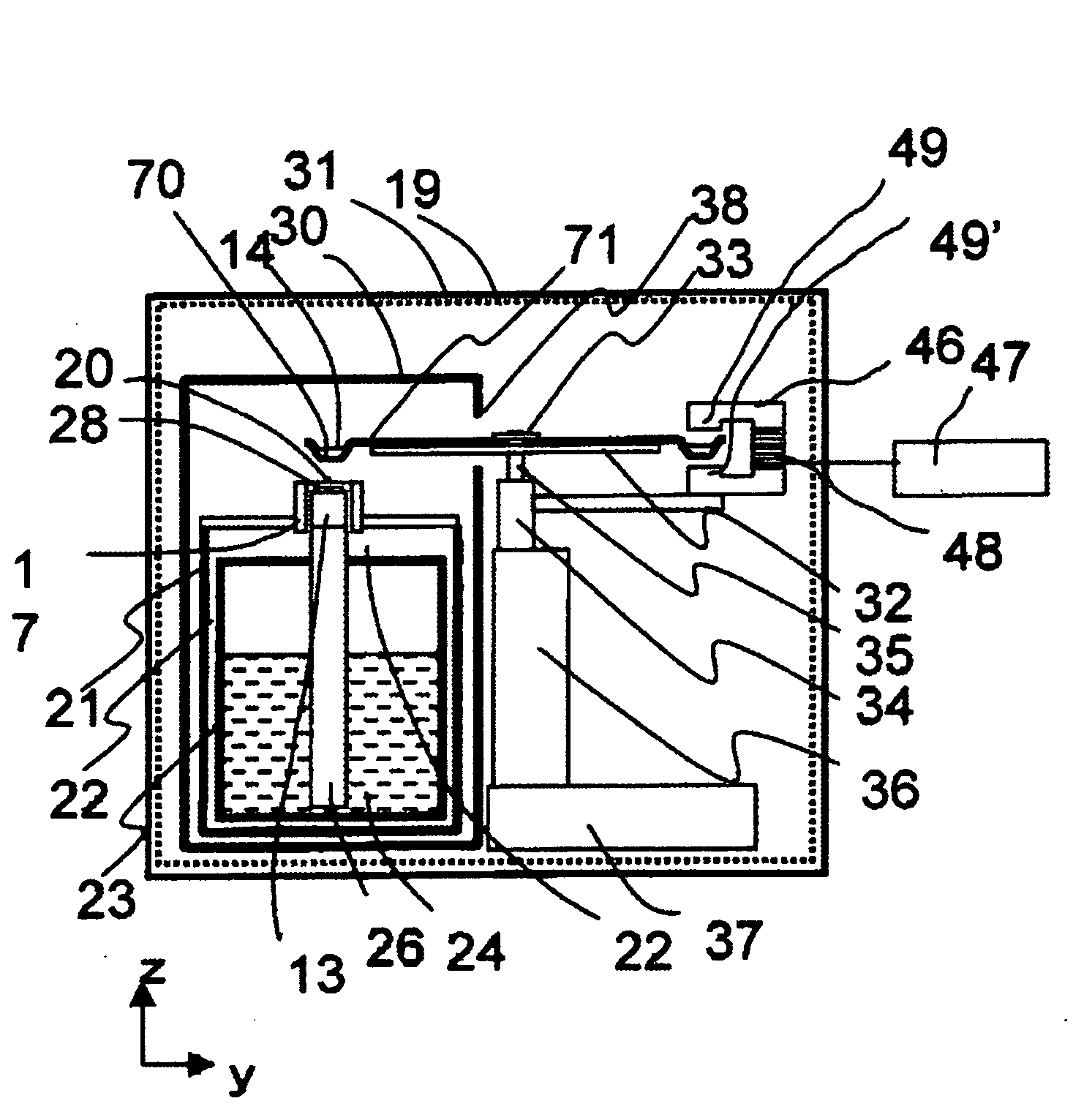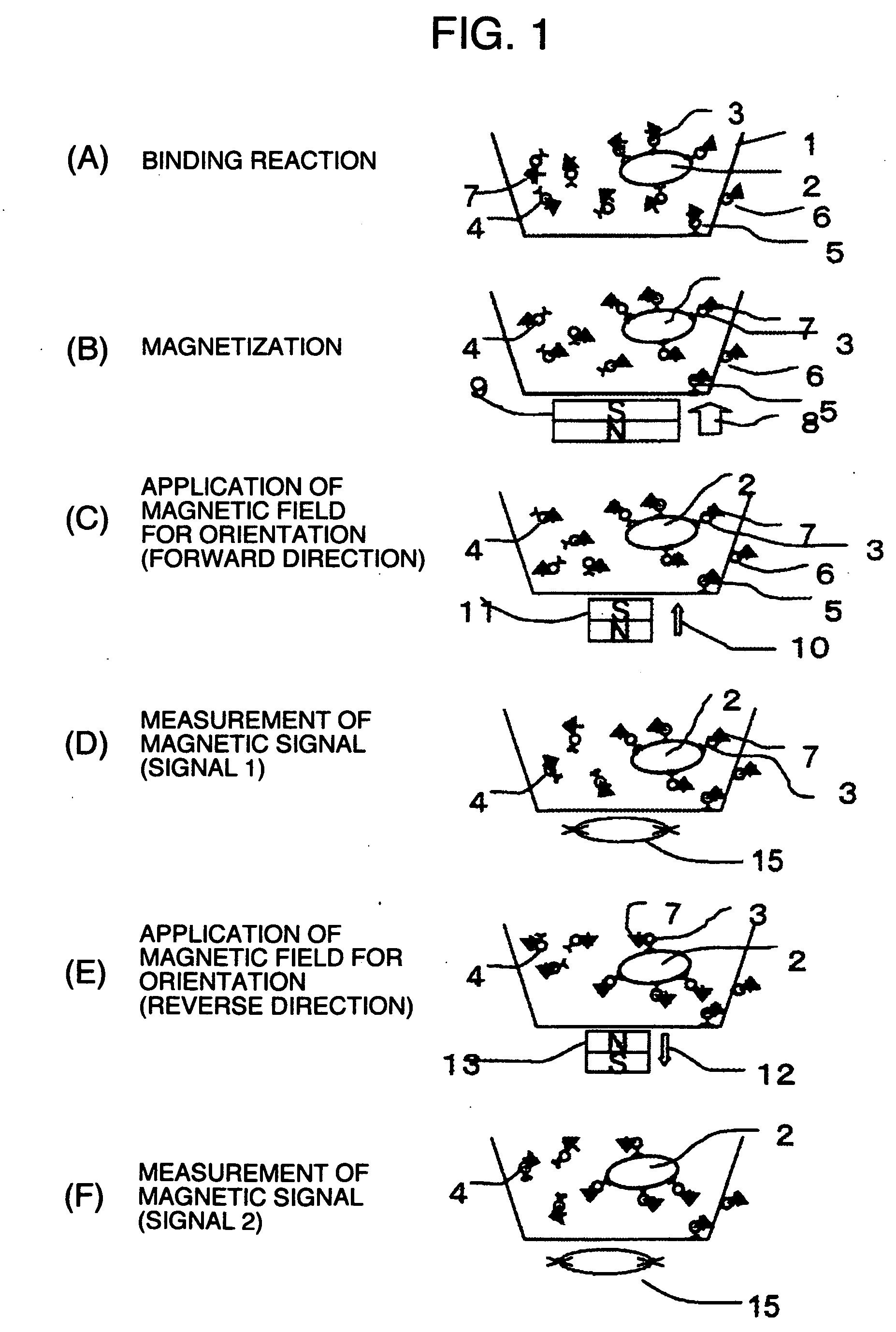Method and system for detection of biomaterials using magnetic marker
a biomaterial and magnetic marker technology, applied in the direction of magnetic property measurement, material magnetic variables, instruments, etc., can solve the problems of insufficient detection sensitivity, new problems such as impurities and contamination of containers, and it is extremely difficult to suppress the inclusion of magnetic impurities completely, etc., to achieve easy application, influence of fringing field, and high sensitivity
- Summary
- Abstract
- Description
- Claims
- Application Information
AI Technical Summary
Benefits of technology
Problems solved by technology
Method used
Image
Examples
embodiment 1
[0043]FIG. 3 is a sectional view showing the configuration of a magnetic bio-inspection system which is one embodiment of the present invention. In order to reduce input of ambient magnetic noise to a SQUID 28, the SQUID and a cooling container 21 for cooling the SQUID are surrounded by an electromagnetic shield 29 and magnetic shields 30 and 31. The magnetic shield 29 is constituted of a metal material with low electric resistance such as aluminum, and the magnetic shields 30 and 31 are constituted of a material with a high magnetic permeability such as permalloy. A cutout hole 38 for inserting a specimen container 71 therein is formed in a part of the magnetic shield 30.
[0044]The specimen container 71 is fixed to a rotating shaft 35 by a fixing screw 33, on a non-magnetic disk-shaped specimen table 32. FIG. 4 shows a schematic view of the specimen container 71 used in the experiment. The container is made of a non-magnetic material such as a resin. The container 71 is circular, ha...
embodiment 2
[0059]In the present embodiment, two magnetizing mechanisms 42 and 43 with reverse polarities from each other are placed on the circumference on which the specimen container 71 rotates as shown in FIG. 10. In embodiment 1, the direction of the external magnetic field for orientation is reversed by disposing the magnetizing mechanism 42 in the vertically inverted position, but in the present embodiment, the direction of the external magnetic field for orientation which is applied to the specimen immediately before measurement can be reversed by reversing the rotating direction of the specimen container 71. The specimen passes through the two magnetizing mechanisms, but the magnetic moments of the specimen are aligned in the direction of the magnetic field of the magnetizing mechanism which the specimen passes immediately before measurement.
[0060]As for the two magnetizing mechanisms 42 and 43, with the position of the SQUID 28 set at zero degrees, the magnetizing mechanism 42 is inst...
embodiment 3
[0062]In the present embodiment, as shown in FIG. 11, on the circumference on which the specimen container 71 rotates, the two magnetizing mechanisms 42 and 43 with reverse polarities from each other are placed, and two SQUIDs 28 and 28′ are further placed. In embodiment 2, by reversing the rotating direction of the specimen container 71 by using the two magnets, the direction of the external magnetic field for orientation which is applied to the specimen immediately before measurement is reversed, but in the present embodiment, by disposing the two magnetic sensors and by rotating the specimen in the arrow direction in FIG. 11, the magnetic signal after passing the magnetizing mechanism 42 can be measured with the SQUID 28, and the magnetic signal after passing the magnetizing mechanism 43 can be measured with the SQUID 28′.
[0063]The magnetizing mechanism 43 has the same structure as the magnetizing mechanism 42, but the direction of its magnetic field is in the reverse direction. ...
PUM
 Login to View More
Login to View More Abstract
Description
Claims
Application Information
 Login to View More
Login to View More - R&D
- Intellectual Property
- Life Sciences
- Materials
- Tech Scout
- Unparalleled Data Quality
- Higher Quality Content
- 60% Fewer Hallucinations
Browse by: Latest US Patents, China's latest patents, Technical Efficacy Thesaurus, Application Domain, Technology Topic, Popular Technical Reports.
© 2025 PatSnap. All rights reserved.Legal|Privacy policy|Modern Slavery Act Transparency Statement|Sitemap|About US| Contact US: help@patsnap.com



